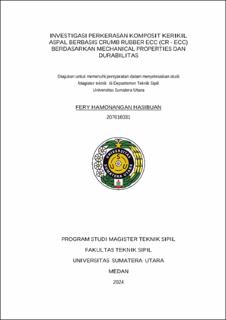| dc.description.abstract | The increasing number of motorized vehicles in Indonesia has caused
the amount of used tire waste to increase. This can be dangerous for the
environment because used tires are very difficult for soil microbiology to
decompose and take a long time to break down. One way to deal with used tire
waste is to use it as construction material and apply it to civil construction
pavement, especially roads. In this research, the application of used tire waste is
used as a forming material, namely Engineered Cementitious Composite (ECC).
The results of this research used Mix Design proportions of 15 variations and
were divided into three types, namely type I coded FCR, Type II coded CRE and
Type III coded TCRE. where each type has differences in the ratio of aggregate
composition and water-cement factor. The percentage proportions of the crumb
rubber mixture are different, namely 0%, 2.5%, 7.5%, 10%, 12.5% of the cement
weight. Type-I composition with specimen code FCR, uses 250 kg of cement per
cubic meter, cement water factor = 0.415, weight of sand = 1.1 times the weight
of cement, Type-II with specimen code CRE also uses cement of 250 kg per cubic
meter , cement water factor = 0.42, weight of sand = 1.1 times the weight of
cement. Type-III with specimen code TCRE, uses cement weight taken as 260 kg
cement per cubic meter, cement water factor = 0.45, and sand weight = 1.1 times
the weight of cement. while the superplasticizer was 2.5% and palm shell ash was
taken at 10% of the cement weight for the three types of test objects. There were
27 cube-shaped test objects measuring 150x150x150 mm and 9 beam-shaped test
objects measuring 150x150x600 mm. Then trial and error testing was carried out
to obtain the CR-ECC compressive strength value at 3 days of age. Based on the
results of the CR-ECC average compressive strength test, it ranges from 17.70 to
37.28 MPa. Based on the results of the CR-ECC asphalt gravel compressive
strength test, the highest compressive strength value was in sample C at the age of
28 days, namely 6.85 Mpa. The results of the bending test show that the largest
average value of maximum load is on sample 28A with a value of 6.83 kN and the
average value of maximum deflection is on sample 28 B with a value of 10.64
mm. The results of the impact test at the age of 3 days showed hairline cracks at
the 5th blow and cracks along the right and left edges or edge breaks at the 8th to
10th blows. Meanwhile, the impact test at the age of 7 days resulted in an average
of hairline cracks occurring at the 8th and no blows. edge rupture occurs. And at
the age of 28 days, the average result was that a line crack occurred at the 9th
blow and no two ruptures occurred. Apart from that, from the results of the fire
resistance test at the age of 3 days, it was found that at a combustion temperature
above 300 degrees, the asphalt on the surface of the test object began to melt, with
signs of water coming out of the test object. Meanwhile, at the age of 7 days,
asphalt begins to melt at a combustion temperature above 400 degrees and at the
age of 28 days, asphalt begins to melt at a combustion temperature above 500
degrees celsius. | en_US |


